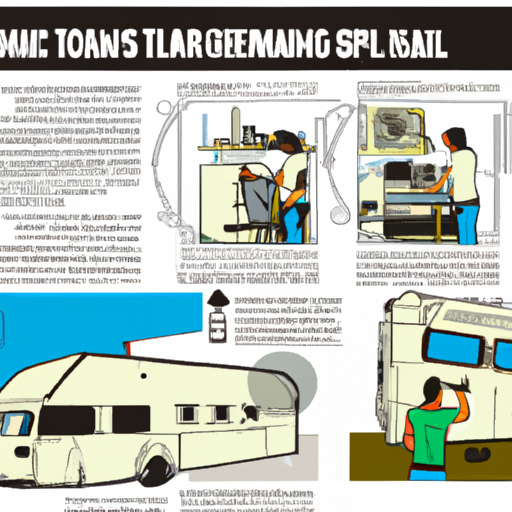Introduction
RV maintenance and repairs can be daunting for those who are new to the RV lifestyle. However, with the right knowledge and tools, you can easily perform routine maintenance and repairs on your RV. This guide will provide step-by-step instructions on how to perform routine RV maintenance and repairs. From changing the oil to replacing a tire, this guide will provide you with the information you need to keep your RV running smoothly. With this guide, you can be sure that your RV is in top condition and ready for your next adventure.
Step-by-Step Guide to Replacing the RV Battery
Replacing your RV battery is a relatively simple process that can be done in a few steps. Here’s a step-by-step guide to help you get the job done.
1. Start by disconnecting the negative cable from the battery. This will help prevent any electrical shocks or sparks.
2. Next, remove the battery from its compartment. This may require some effort, as the battery may be held in place with bolts or clamps.
3. Once the battery is out, inspect it for any signs of damage or corrosion. If the battery is damaged, it’s best to replace it with a new one.
4. Now it’s time to install the new battery. Make sure to follow the manufacturer’s instructions for proper installation.
5. Once the new battery is in place, reconnect the negative cable.
6. Finally, test the new battery to make sure it’s working properly.
And that’s it! Replacing your RV battery is a simple process that can be done in a few steps. Just make sure to follow the manufacturer’s instructions and take all necessary safety precautions.
How to Change the Oil in Your RV: A Step-by-Step Guide
Changing the oil in your RV is an important part of regular maintenance that will help keep your vehicle running smoothly. It’s not as difficult as it may seem, and with a few simple steps, you can do it yourself in no time. Here’s a step-by-step guide to help you get started.
1. Gather your supplies. You’ll need a new oil filter, a new oil drain plug gasket, a new oil filter gasket, a new oil filter wrench, a funnel, and a container to catch the old oil.
2. Park your RV on a level surface and make sure the engine is off and cool.
3. Locate the oil drain plug and remove it. Place the container underneath the plug to catch the old oil.
4. Once the oil has drained, replace the drain plug and gasket.
5. Locate the oil filter and remove it. Place the new oil filter gasket on the new filter and use the oil filter wrench to tighten it.
6. Pour the new oil into the engine using the funnel.
7. Start the engine and let it run for a few minutes.
8. Check the oil level and add more if necessary.
9. Dispose of the old oil and filter properly.
That’s it! Changing the oil in your RV is a simple process that will help keep your vehicle running smoothly. With a few simple steps, you can do it yourself in no time.
A Comprehensive Guide to Troubleshooting RV Electrical Problems
Are you having trouble with your RV electrical system? Don’t worry, you’re not alone! Many RV owners experience electrical problems at some point, and it can be a real headache to figure out what’s wrong. But don’t despair – with a little bit of knowledge and some troubleshooting, you can get your RV electrical system back up and running in no time.
First, let’s start with the basics. Make sure all your RV’s electrical connections are secure and that all the wires are properly connected. Check the circuit breakers and fuses to make sure they’re not tripped or blown. If they are, replace them with new ones.
Next, check the battery. Make sure it’s fully charged and that the connections are clean and secure. If the battery is old, it may need to be replaced.
If the battery is fine, then it’s time to check the wiring. Look for any loose or frayed wires, and make sure all the connections are secure. If you find any problems, you may need to replace the wiring.
Finally, check the RV’s electrical system for any shorts or other problems. If you find any, you may need to have a professional electrician come out and take a look.
Hopefully, these tips will help you troubleshoot your RV electrical problems. If you’re still having trouble, don’t hesitate to contact a professional electrician for help. Good luck!
Step-by-Step Guide to Replacing RV Tires
1. Gather the necessary tools and supplies. You’ll need a jack, jack stands, a lug wrench, a tire iron, and a torque wrench. You’ll also need a new set of tires.
2. Park your RV on a flat, level surface. Make sure the parking brake is engaged and the wheels are chocked.
3. Loosen the lug nuts on the wheel you’re replacing. Use the lug wrench to loosen the nuts, but don’t remove them yet.
4. Jack up the RV and place the jack stands under the frame. Make sure the jack stands are secure and won’t slip.
5. Remove the lug nuts and take off the wheel. Use the tire iron to remove the wheel from the hub.
6. Install the new wheel. Place the wheel on the hub and secure it with the lug nuts.
7. Tighten the lug nuts. Use the torque wrench to tighten the lug nuts to the manufacturer’s specifications.
8. Lower the RV and remove the jack stands.
9. Repeat the process for the other wheels.
10. Take your RV for a test drive to make sure the new tires are working properly.
How to Winterize Your RV: A Step-by-Step Guide
Winterizing your RV is an important part of preparing for the cold months ahead. It’s a simple process that will help protect your RV from the harsh winter weather and keep it in good condition for years to come. Here’s a step-by-step guide to help you get started.
1. Clean the exterior of your RV. Start by giving your RV a good wash and wax. This will help protect the exterior from the elements and keep it looking great.
2. Inspect the roof. Check for any signs of damage or wear and tear. If you find any, make sure to repair it before winterizing.
3. Check the seals. Make sure all the seals around windows, doors, and vents are in good condition. If they’re not, replace them.
4. Drain the water system. This includes the fresh water tank, hot water heater, and all other water lines. Make sure to use a non-toxic antifreeze to protect the system from freezing.
5. Disconnect the battery. This will help prevent any damage from cold temperatures.
6. Cover the RV. Invest in a good quality cover to protect your RV from the elements.
7. Store the RV. If possible, store your RV in a garage or other enclosed space. This will help protect it from the cold and keep it in good condition.
Following these steps will help ensure your RV is ready for the winter months ahead. Taking the time to winterize your RV now will save you time and money in the long run.
Conclusion
In conclusion, step-by-step guides for performing routine RV maintenance and repairs are an invaluable resource for RV owners. They provide detailed instructions on how to properly maintain and repair their RV, as well as tips and tricks to help make the process easier. With the help of these guides, RV owners can ensure their RV is in top condition and ready for any adventure.

